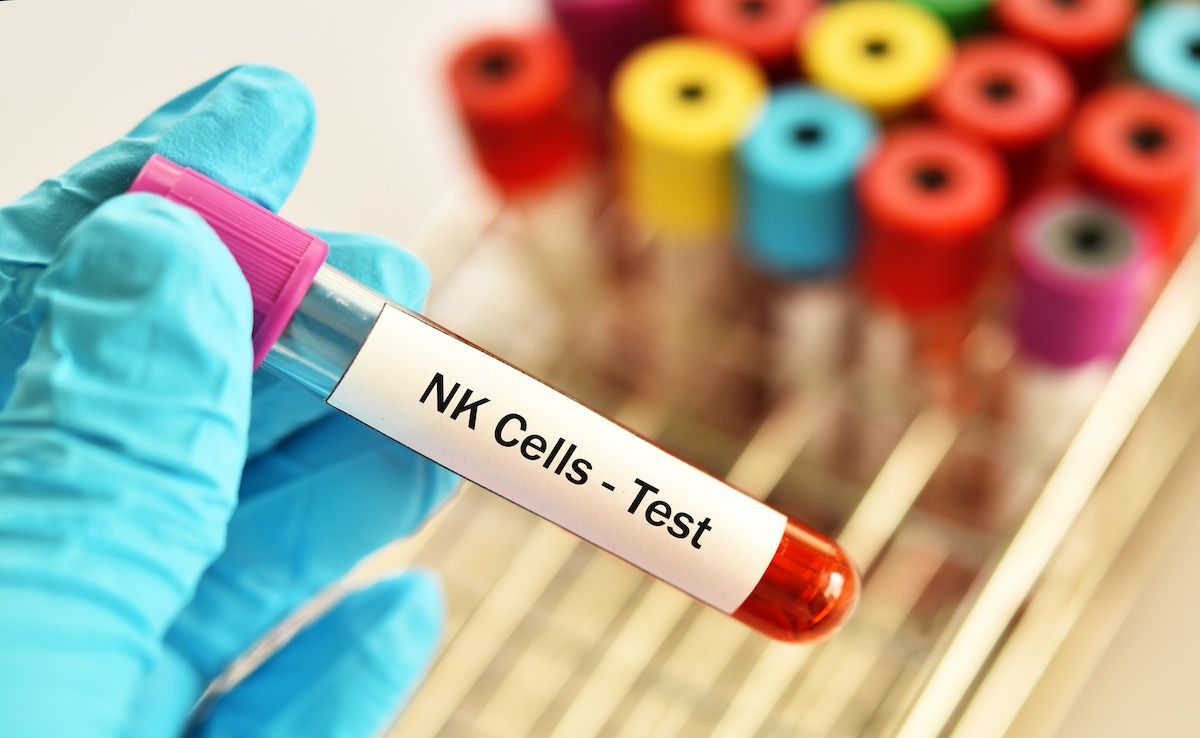- Center on Health Equity & Access
- Clinical
- Health Care Cost
- Health Care Delivery
- Insurance
- Policy
- Technology
- Value-Based Care
KIR2DS2+ NK Cells Show Potential in HCC and Leukemia Treatment
These findings suggest that KIR2DS2-positive (KIR2DS2+) natural killer (NK) cells could be an attractive therapeutic target for in vivo strategies, although enhanced effector function is lost during ex vivo expansion needed for NK cell–based therapies, such as chimeric antigen receptor–NK cell treatment.
Directly targeting KIR2DS2-positive (KIR2DS2+)natural killer (NK) cells in patients with cancer may be an effective approach for enhancing effector function, suggest new study findings detailed in Frontiers in Oncology.1
However, although the findings suggest that KIR2DS2+ NK cells could be an attractive therapeutic target for in vivostrategies, enhanced effector function is lost during the ex vivo expansion needed for NK cell–based therapies, such as chimeric antigen receptor(CAR)-NK cell treatment.
Using NK cells from healthy donors to overcome certain barriers and challenges with CAR T-cell treatment continues to be explored, although effective adoptive transfer of NK cells is currently stifled by the heterogenous nature of these cells. As a result, efforts have been targeted at identifying which genetic and phenotypic traits of NK cells could signal improved function duringex vivo expansion.
For their analthisysis, the researchers analyzed 3 subsets of KIR2DS2 NK cells from healthy donors and patients with chronic lymphocytic leukemia and hepatocellular carcinoma. | Image Credit: © jarun011-stock.adobe.com

One focus has been on the KIR family, including KIR2DS2, which has shown enhanced effector function in in vivo studies.
“Immunogenetic and functional studies have identified that the activating receptor KIR2DS2 is associated with enhanced NK cell function against cancer cells. However, it was unclear whether KIR2DS2+ NK cells retain their enhanced functional state in cancer patients or following ex vivo expansion protocols which are required for NK cell therapies, such as adoptive transfer and CAR-NK cells,” explained the researchers of the study, noting that expansion of NK cells ex vivo is crucial for ensuring sufficient cell numbers from donors.
For their analysis, the researchers analyzed 3 subsets of KIR2DS2 NK cells from healthy donors and patients with chronic lymphocytic leukemia (CLL) and hepatocellular carcinoma (HCC). NK cells have been shown to play a pivotal role in HCC, with multiple trials underway assessing the effectiveness of NK cell–based treatment in the cancer type, which carries a poor prognosis due to late diagnosis and rapid disease progression.2
The group found that the KIR2DS2high NK cells, compared with KIRDS2-negative NK cells, had more pronounced activation to targeted antibodies. Across all concentrations of the EGFR antibody cetuximab and the PD-L1 inhibitor avelumab, the KIR2DS2high cells showed higher degranulation against HCC cells compared with KIR2DL3/L2high and KIR2DL3/L2/S2-negative (KIR2DL3/L2/S2–) NK cells alone and in combination.
In NK cells derived from patients with CLL, KIR2DS2high NK cells had significantly enhanced activation compared with KIR2DL3/L2/S2– NK cells and KIR2DL3/L2high NK cells across rituximab concentrations. Across obinutuzumab concentrations, KIR2DS2high had enhanced activation compared with KIR2DL3/L2/S2– NK cells but did not have statistically significantly enhanced activation compared with KIR2DL3/L2high NK cells.
The effect seen in vivo was lost following ex vivoexpansion. The group isolated NK cells from the peripheral blood of healthy volunteers, the same way they would for allogeneic adoptive transfer treatment strategies.
Expansion of these NK cells with interleukin-2 (IL-2) led to a loss of superior activation of KIR2DS2high NK cells relative to NK cells lacking KIR2DL3/L2/S2 expression but not compared with the inhibitory KIR2DL3/L2high population. Similar results were observed after expansion using IL-12/15/18.
“However, the superior activation against KIR2DL3/L2high cells was likely due to less inhibitory KIR signalling in the KIR2DS2high population because the enhanced reactivity was lost against HLA-null target cells,” described the researchers. “This contrasts with previous work, which demonstrated that healthy donor KIR2DS2high NK cells primed with IL-15 overnight have enhanced activity in the absence of HLA expression on target cells. This therefore indicates that KIR2DS2+ NK cells from peripheral blood lose their association with enhanced functional capacity following expansion.”
References
1. Graham LV, Fisher JG, Doyle ADP, et al. KIR2DS2+ NK cells in cancer patients demonstrate high activation in response to tumour-targeting antibodies. Front Oncol. Published online September 2, 2024. doi:10.3389/fonc.2024.1404051
2. Wang X, Yang T, Shi X.NK cell-based immunotherapy in hepatocellular carcinoma: An attractive therapeutic option for the next decade. Cell Signal. Published online September 12, 2024. doi:10.1016/j.cellsig.2024.111405
